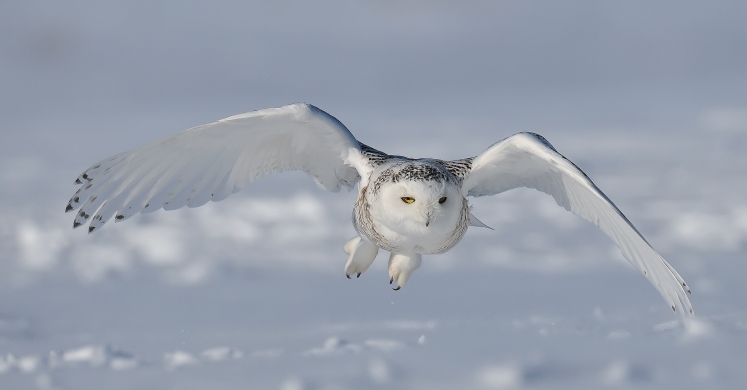Blog

#bioPGH Blog: A Snowy Owl Irruption!
 A resource of Biophilia: Pittsburgh, #bioPGH is a weekly blog and social media series that aims to encourage both children and adults to reconnect with nature and enjoy what each of our distinctive seasons has to offer.
A resource of Biophilia: Pittsburgh, #bioPGH is a weekly blog and social media series that aims to encourage both children and adults to reconnect with nature and enjoy what each of our distinctive seasons has to offer.
For most of us who live in Pennsylvania, the most common time to spot a snowy owl might be when we’re waiting for a letter to arrive from a magical school. However, if you’re a birding enthusiast and you’d like to catch a glimpse of this feathered Arctic beauty, you might be in luck! There is currently a snowy owl irruption underway, and snowys have spotted across the Northeastern states and even as far south as North Carolina. But what is an irruption, and why would tundra-dwelling birds come down this far south? Let’s explore!
First of all, what is an “irruption?” It can be broadly defined as a dramatic surge in number of animals, but the ornithological (bird-related) definition specifically refers to a disruption in normal movement or migratory patterns. Jim Bonner, executive director of the Western Pennsylvania chapter of the Audubon Society, explains the biology behind this disruption in normal snowy owl wintering patterns and how it is directly linked to snow owls’ primary food source: lemmings.
“The snowy owl population is tied to the lemming population, and lemmings have cyclical population numbers,” explains Bonner. High prey availability and unusual travel patterns are linked because of an important part of nature that humans often forget: when resources are limited, animals’ offspring don’t always survive to adulthood. For example, if a snowy owl laid a clutch of five eggs, it takes quite a bit of work for parents to provide enough food for all of the young. In years of low prey availability, fewer offspring survive. In irruption years, though, after a summer boom of lemmings, this is not the case.
“About every four to five years, with an abundance of prey availability, more young snowys survive than usual. As these young snowys start to grow up and disperse, they can travel further—move out further south.”
Thus, contrary to popular belief that snowys travel because of a lack of food, they are actually exploring much greater distances because they’ve been well-fed! In fact, the birds that are banded during irruption years tend to be heavier than those that are banded in normal years. The birds also tend to be younger—not necessarily young-of-the-year, but younger than the average first breeding age of 2 or 3 years old.
If you hope to catch a glimpse of these rare birds while they’re on our part of the continent, your best bet is to seek out their ideal habitat types. In the Arctic, snowy owls live on the open tundra—frozen grasslands too far north for trees to survive. Thus, when snowys come down this far south, we can still expect to see these owls avoiding heavily forested areas.
“They are absolutely ‘non-tree’ birds, so to speak,” Bonner says. “They stay on rooftops, or other perches in wide open spaces, especially around airports.” This makes sense when you consider their hunting strategies. Relatively unique in the owl world, snowy owls are actually diurnal (awake during the day time), and they rely on their eyesight to detect prey.
“They will purposely sit out in the wide open to look for prey,” Bonner notes. “They perch and wait. The strategy is they are not burning energy looking for prey.”
To find out where snowys have been spotted, check out the openly available data on websites like eBird and iNaturalist. As of post time, a snowy owl was definitively spotted as nearby as Ford City, and there was an unconfirmed sighting within Allegheny County last week.
These birds won’t stay down here forever, though. Snowy owls do often migrate south in the winter (though not this far south), but they will return to their summering grounds for the breeding season. Most likely, the birds will be on their way back north by February. While you have the chance, be sure to get out there and look!
Connecting to the Outdoors Tip: Birders are in luck in more ways than one! Besides the snowy owl irruption, the chapters of the Audubon Society all over the country are hosting their annual Christmas Bird Counts—the largest and longest-running citizen science effort in the world. Even if you don’t have a lot of experience birding, this is the perfect opportunity for beginners to get involved alongside seasoned experts. To find a count near you, check out Audubon Society of Western PA’s website. If you happen to spot a snowy on your own, you can document it on eBird (a resource of the Cornell Lab of Ornithology) or iNaturalist. You can upload pictures and location to either/both, and other birders can confirm your ID or keep track of the irruption.
Continue the Conversation: Share your nature discoveries with our community by posting to Twitter and Instagram with hashtag #bioPGH, and R.S.V.P. to attend our next Biophilia: Pittsburgh meeting.
Resources
Project Snowstorm: What is an Irruption
Photo Credits: Wikimedia User Bert de Tilly CC-BY-SA-3.0 and Pexels CC0
